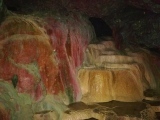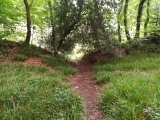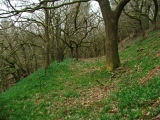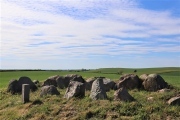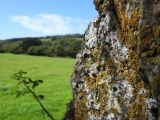Andy Burnham's Blog, page 188
September 11, 2020
Holywell Bay
This must be the most unusual location for a holy well. The well is in the cave and only accessible at low tide. Water seeps from the multi-coloured rock and mothers formerly crossed the sands of Holywell Bay to immerse their ailing children in the healing water. Real pagan magic here with no obvious Christianisation.
Published on September 11, 2020 10:19
August 29, 2020
Bishops Wood Fort
A hillfort near Truro with a strong univallate defence and a hill top situation, densely afforested. It consists of a large bank with deep outer ditch. There are three gaps on the NE, SE and W. The former is small and probably modern. The other two are probably original.
Published on August 29, 2020 11:52
August 27, 2020
Tregarthen Hill
Heather-covered entrance grave on Tregarthen Hill, Tresco, Isles of Scilly. Kerbstones and a chamber with capstones.
Published on August 27, 2020 12:49
August 26, 2020
Kibyra
Visitors rush to Kibyra to see the 2000 year old Medusa mosaic, more details in the comments on our page. Possibly originally settled by Lydians, this city in Burdur Province, Turkey became the head of a tetrapolis including the neighbouring cities of Boubon, Balboura and Oinoanda in the 2nd century BCE. The city was visited by Hadrian in 129 CE.
Published on August 26, 2020 13:40
Burfa Camp
One of the ramparts of Burfa hillfort in Powys. The interior is very overgrown with thickets of saplings, brambles and nettles making it difficult to get any perspective of the fort. According to Coflein the size is 579m by up to 187m, with a bank and ditch above steep slopes, except to the west, where there are three to four banks and ditches.
Published on August 26, 2020 07:31
Lochmaben Stane
A glacial erratic appropriated as a standing stone, and alleged stone circle in Dumfries and Galloway. In the 16th century, it was frequently used as the meeting place between the Scots and English wardens for the administration of justice, and in comparatively recent times local gatherings took place at this stone.
Published on August 26, 2020 06:15
August 25, 2020
Klokkerholm Stenkiste
Runddysse (Burial Chamber) in Randers, Denmark. Rectangular stone cist. 8 x 3 x 1 meter. 6 stones to the north, one stone to the east, 5 stones to the south and one stone in the west.
Published on August 25, 2020 15:28
August 24, 2020
The Wimblestone
A triangular shaped standing stone 1.8m tall with a hole through it, near Winscombe in Somerset. Additional stones were thought to have once been nearby. Local traditions state there is a treasure hidden beneath the stone and that the stone walks when it either hears the clock strike twelve or between the hours of midnight and dawn and it is said that during its nocturnal wanderings a heap of shining gold has been seen glistening in the moonlight. Allegedly a farmer once tried to remove it with chains and two horses but failed.
Published on August 24, 2020 12:57
Hunn West Gravfelt
This burial site dates from the Iron Age and is the westernmost of three burial sites at Hunn, Østfold, Norway. It contains 56 round barrows, 3 long barrows, a burial cairn and traces of a prehistoric sunken road. Some of the burial mounds date from around 2000 years ago and others from the Viking era.
Published on August 24, 2020 12:56
Slawisches Hügelgräberfeld Löcknitz
Barrow Cemetery in Mecklenburg-Western Pomerania, Germany. The cemetery is one of the rare preserved Slavic burial mound fields in Vorpommern.
Published on August 24, 2020 12:48

